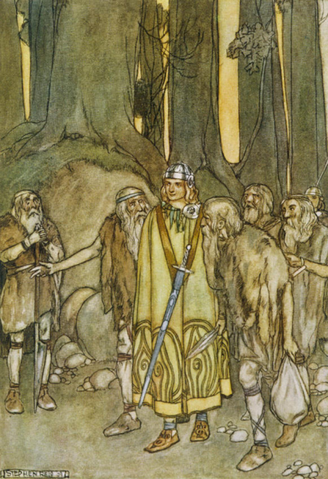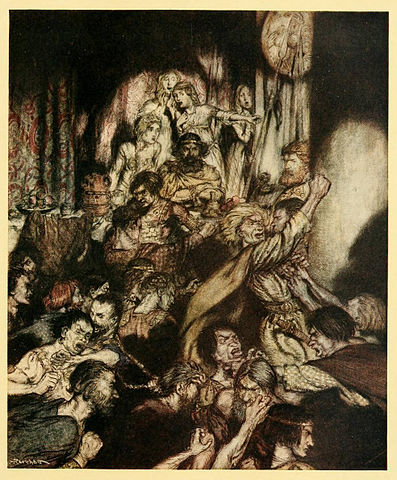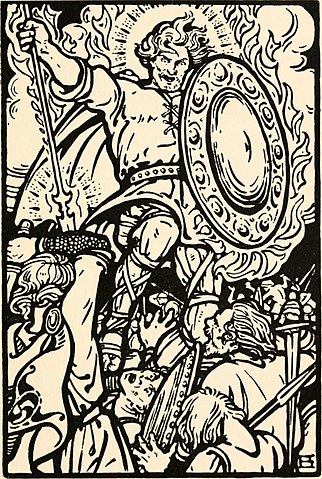The Battle of Cnucha: How One Conflict Shaped Ireland’s Greatest Hero
Ireland’s ancient myths contain daring heroes, fierce battles, and magical moments. Among the most celebrated figures is Fionn mac Cumhaill, leader of the Fianna—an elite band of warriors and hunters. But how did this legendary hero first come to be? Much of his story begins with The Battle of Cnucha, a key event in Irish mythology that set Fionn’s destiny in motion.
In this post, we will explore the background of The Battle of Cnucha, the main figures involved, and why it had such a lasting impact on the tales of early Ireland.
Table of Contents
Mythological Context
The Fenian Cycle
Irish mythology is traditionally divided into several “cycles,” each focusing on different groups of characters and stories. The Fenian Cycle (also called the Fianna Cycle) centres on Fionn mac Cumhaill and his companions, the Fianna. These stories emphasise themes of loyalty, bravery, and the trials of a hero’s journey.
Role of Warrior Bands (the Fianna)

The Fianna were not ordinary soldiers. They were known for their hunting skills, strict codes of honour, and devotion to protecting Ireland’s people. Before Fionn became their leader, the Fianna were made up of rival factions, each vying for power and recognition. This factional tension forms the backdrop to The Battle of Cnucha.
Key Figures and Factions
Cumhal (Fionn’s Father)
At the time leading up to The Battle of Cnucha, Cumhal (sometimes spelt Cumhall) was in charge of one major branch of the Fianna. He was a respected warrior, but his growing influence sparked concern among other leaders and possibly even among Ireland’s High King.
Goll mac Morna
Another mighty warrior, Goll mac Morna, led a rival faction of the Fianna known as Clann Morna. Their relationship with Cumhal’s followers was tense—both groups wanted to be the most prominent force within the Fianna.
Conn of the Hundred Battles
During many Fenian tales, Conn of the Hundred Battles (High King of Ireland) appears as a figure of considerable power. Though accounts vary, some say he felt threatened by Cumhal’s rise. Others suggest that it was pressure from Cumhal’s rivals that persuaded Conn to act against Cumhal.
Tadg mac Nuadat and Muirne
Tadg mac Nuadat was a druid or chieftain who became part of the conflict due to Cumhal’s actions. In some versions of the story, Cumhal’s marriage (or abduction) of Tadg’s daughter, Muirne, contributed to the tensions. Muirne was pregnant with Fionn at the time of the battle, making her a key figure in the legend.
Causes of the Conflict

Power Struggles Among the Fianna
Leading a warrior band as influential as the Fianna brought prestige—and danger. Cumhal’s growing fame might have threatened other factions and even the authority of the High King. As a result, Goll mac Morna and others saw an opportunity to remove Cumhal from power.
Marriage or Abduction of Muirne
According to some versions of the tale, Tadg mac Nuadat complained to Conn about Cumhal either marrying or abducting his daughter without permission. In ancient Ireland, such an offence could have serious political consequences, as marriages often forged alliances or caused feuds.
Factional Rivalries
Above all, the feud between Clann Baoiscne (Cumhal’s group) and Clann Morna (Goll’s group) lay at the heart of the conflict. Both families wanted to control the Fianna, and removing Cumhal seemed the quickest way for Goll to secure leadership.
The Battle Unfolds
Gathering Armies
Encouraged by their resentment of Cumhal’s power, Goll mac Morna and his allies assembled an army. In some versions, Conn of the Hundred Battles gave his support (or at least did not prevent the attack), fearing Cumhal’s influence might grow beyond his control.
The Clash at Cnucha
Although the exact location is debated, many identify Cnucha with the Castleknock area near Dublin. The two forces met in a fierce confrontation. Known as The Battle of Cnucha (Cath Cnucha in Irish), this fight was not just a tiny skirmish—important leaders and champions took part on both sides. The outcome changed the future of the Fianna forever.
Cumhal’s Defeat and Death
Ultimately, Cumhal’s forces were overwhelmed. Goll mac Morna is generally credited with striking the fatal blow against Cumhal, taking his position as the new leader of the Fianna. Some accounts mention that Goll or other rivals seized any treasure or magical weapons Cumhal possessed, further cementing Goll’s victory.
Aftermath and Legacy
Power Vacuum
With Cumhal gone, Goll mac Morna assumed control of the Fianna. This shifted the balance of power among Ireland’s warrior bands, leaving Conn of the Hundred Battles more secure and placing the Fianna under new leadership.
Fionn’s Hidden Upbringing
One of the most significant consequences of The Battle of Cnucha was the fate of Muirne, who was pregnant with Cumhal’s child. After Cumhal’s death, Muirne feared for her son’s safety since he could become a target for the new leadership. She entrusted the boy—first known as Demne—to wise women (often named Bodhmall and Liath Luachra) who raised him in secrecy, far from courtly and warrior politics. In time, he took the name Fionn (meaning “fair” or “bright”).
Birth of a Future Hero

Growing up in the wild taught Fionn survival skills and developed his natural talents. This background helped him become a resourceful and cunning warrior who would later reclaim the leadership of the Fianna. His father’s fall at The Battle of Cnucha thus directly led to the rise of one of Ireland’s greatest heroes.
Cultural and Literary Significance
Storytelling and Oral Tradition
The Battle of Cnucha is mentioned in several medieval texts, including “Macgnímartha Finn” (The Boyhood Deeds of Fionn). Passing down these tales in oral tradition helped preserve Ireland’s rich cultural heritage. Over time, monks and scribes recorded these stories in manuscripts, ensuring they would survive into the modern era.
Symbolic Themes
This battle showcases the cyclical nature of power—leaders rise and fall, yet heroic qualities endure. It highlights the father–son legacy, where Fionn inherits both a cause and a challenge from his slain father. The rivalry theme within the Fianna also runs through many later Fenian stories, reminding us that internal conflict can be as dangerous as external threats.
Conclusion
The Battle of Cnucha is a defining moment in the Fenian Cycle of Irish mythology. It set the stage for Fionn mac Cumhaill’s entire journey—from an orphaned boy growing up in the wilderness to the legendary leader of the Fianna. The clash at Cnucha shows us that even in a mythic landscape of gods and warriors, political tensions, family feuds, and personal ambitions can lead to momentous change. If you’d like to explore more, keep an eye out for other Fenian Cycle tales, as each story threads together to create the vast tapestry of Ireland’s heroic past.
Further Reading and Exploration:
- Translations of the Táin Bó Cúailnge
- The Story of Ireland by Neil Hegarty
- Early Irish Myths and Sagas by Jeffrey Gantz
- A New History of Ireland: Prehistoric and Early Ireland, edited by Dáibhí Ó Cróinín
- The Knighting of Cú Chulainn
- Birth of Cú Chulainn
